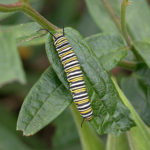Raising Monarch butterflies

It’s not always all grinding and going at Christensen’s Plant Center, sometimes we crew members get to stop and smell the flowers - and during the summer - find some of them crawling with beautiful monarch caterpillars.
Monarchs are not yet an endangered species, but they and their migration are being threatened and need protecting. So at Christensen’s we started rounding up our Monarch caterpillars and putting them into mesh butterfly cages with a milkweed plant for food. Monarchs feed solely on Asclepias, using the toxins in the milkweed to make themselves very unpleasant to predators. Animals and birds who eat a Monarch caterpillar or butterfly get pretty sick from it and won't eat another. There are still a lot of losses, though, so raising and releasing them really helps boost their numbers.



They are voracious feeders, so we check them daily, replacing the host plant as needed. Once they’re nice and fat, they’ll eventually J-up (they hang, head down, in a ‘J’ shape) and morph into a chrysalis within hours. Then after about 10 days, you’ll have a beautiful Monarch butterfly. Easy, right? One day when we came into work, we had three hatched and ready to take off!


Chrysalides start out green, turning clear as the butterfly develops

Male Monarch emerging from his chrysalis
Be careful of escapees though - we had one little guy escape and he ended up morphing into his chrysalis under the table. If you have a cage with a zipper, make sure there’s no one by it when you unzip it or a caterpillar could get caught in it (yes, sadly we learned that one from personal experience). Also beware of invaders: spiders and flies love to sneak in which can be dangerous for the butterflies-in-training! Other predators include wasps, assassin bugs, ants, toads, and even mice.

Plants like Allium, Buddleia, and Liatris seem to be swarming with Monarch butterflies this time of year. Monarchs are an important pollinator for many wildflowers. Providing a safe place for Monarchs to grow and multiply is a rewarding and beautiful experience.
See here for more about growing milkweed: Milkweed for Monarchs - Michigan DNR

Fresh new Monarchs! Female (above) and male (below). Males have a tiny spot on their hind wings.

Common milkweed is a favored host plant for Monarchs
